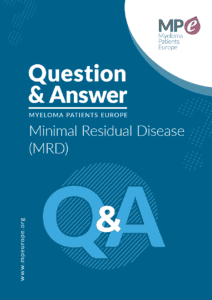What is MRD?
MRD stands for Minimal Residual Disease. It refers to the very small number of myeloma cells that are present in the bone marrow after treatment. The number of remaining cells might be so small that a patient may have no physical sign of disease or experience any symptoms. These remaining cells often cannot be detected through traditional tests of treatment response. However, they have the potential to multiply and cause relapse. The result of MRD assessment is either positive, meaning that myeloma cells are detected, or negative, meaning that myeloma cells are not detected. MRD testing helps to measure the effectiveness of treatment and can help to predict risks of relapse. MRD negativity indicates a very deep response to treatment. If this deep response is maintained over time, with repeat MRD testing, patients will on average, have longer periods of remission and overall survival. However, the full potential of MRD testing is still being explored in clinical trials.
How is response to treatment currently measured?
In myeloma, treatment response is typically measured with tests examining the levels of M-protein and/or free light chains in the serum and urine and the number of plasma cells in the bone marrow.
The sample of myeloma cells is obtained through a bone marrow aspiration and/or biopsy. Assessing the percentage of myeloma cells left in the bone marrow after treatment using these methods involves manually counting cells in a bone marrow sample under a microscope. A complete response would require (among other criteria), less than 5% of myeloma cells in the bone marrow. However, MRD testing methods are much more sensitive, meaning the number of cells analysed is much higher and much more precise. Laboratory specialists can therefore detect or “count” remaining myeloma cells which would otherwise be missed.
How do you test for MRD?
Testing for MRD requires patients to undergo a bone marrow aspiration or bone marrow biopsy to collect a bone marrow sample. The most common MRD tests are next generation flow cytometry (NGF) and next-generation sequencing (NGS). The International Myeloma Working Group defines MRD negativity as no myeloma cells being detected in one hundred thousand cells (100,000) using flow cytometry or next generation sequencing. The latest techniques are even more sensitive and capable of detecting one myeloma cell in one million normal cells. Alongside MRD testing, researchers and doctors also use imaging techniques, such as PET/CT scans, to look at residual disease outside the bone marrow. Measuring MRD from blood samples instead of bone marrow samples is currently being widely researched but is not yet available.
What has research on MRD testing shown so far?
Research has shown that MRD negative patients have a reduced risk of disease progression and improved survival. When compared with other prognostic factors, MRD has also been shown to be superior and the most relevant predictor of clinical outcome. It’s important to remember that MRD negativity does not guarantee longer overall survival or a cure and that a change in an MRD result does not necessary lead to clinical relapse.
How is MRD currently being used and assessed?
MRD is mostly being used within the context of clinical trials. It is not yet ready for widespread use in myeloma, as there are still outstanding questions on when and how to use it and what the results mean in practice. For example, if a patient is MRD positive, is it necessary to switch treatments at this point?
The main questions that MRD clinical trials are currently looking at are:
- How can MRD be used in treatment decision-making? For example, can a patient stop, escalate or change treatment based on MRD positivity or negativity?
- Other questions include:
- If MRD can be used in treatment decision-making, how and when should the tests be conducted?
- How does the sensitivity of MRD testing impact on its usefulness in treatment decision-making?
- What does sustained MRD negativity mean in the long term and in different disease stages? (e.g. newly diagnosed myeloma vs relapsed)
What is the potential of MRD in the real world for patients?
The use of MRD has the potential to be an important improvement and step-towards a personalised approach of treatment for patients. For example, MRD could be predictive of the expected prognosis (i.e. the expected development of disease) and could also allow clinicians to fine-tune the stop, pause, or continuation decisions regarding treatment. It may no longer be necessary to wait for disease symptoms to appear before making treatment decisions or pausing treatment. However, to better understand the impact MRD is likely to have in the real-world, we need to see the data from ongoing clinical trials on its use.
What are the current challenges with MRD and its applicability in the real world?
MRD is currently used mostly in the context of clinical trials, although a minority of myeloma treatment centres use it in clinical practice. While there are clear benefits of using MRD, there are also certain caveats and shortcomings of its use that need to be considered before MRD is used more widely.
- MRD testing may require repeat bone-marrow aspiration and/or biopsy which can negatively impact a patient’s quality of life.
- Even though there is a standardisation process underway, optimal timing of MRD assessment during and after treatment is still unclear.
- It is unclear what MRD negativity means in different subgroups of myeloma patients.
- While increasingly accepted in some settings, treatment decisions based on MRD are under debate and more data is needed.
- Implementing these techniques in hospitals and clinics across Europe will also be a challenge, as specialised equipment and technicians are needed.
MRD testing shows great promise, but more research must be conducted to understand it’s use in treatment decision-making and standardize its measurement.
Learn more
Visit the MPE MRD section to check out our other resources on MRD and learn more!
